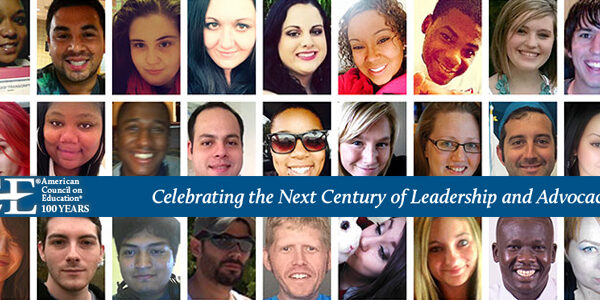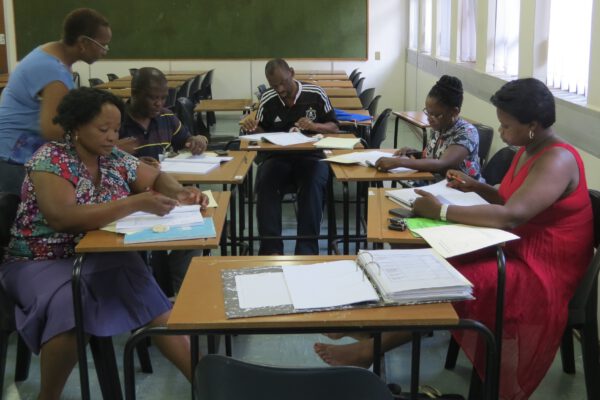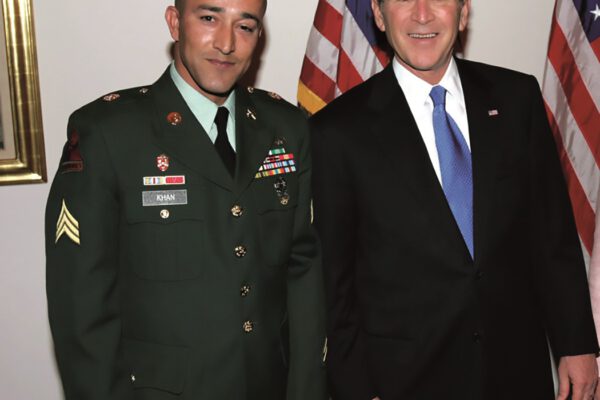By Jon Riskind

As ACE prepares to celebrate its centennial in 2018, this is the first in an occasional series of posts that will look at how ACE initiatives have left an impression on the higher education landscape and impacted peoples’ lives. Pictured above: 2014 Student of the Year Jeffrey Gearhart with ACE President Molly Corbett Broad.
Tara Turley, a single mother and electrician who used her skills to assist her flood-ravaged West Virginia community, is getting a bachelor’s of multidisciplinary studies degree at West Virginia University Online.
Mario Sankis, a former Marine, retired police officer and cancer survivor, finished his first year as a law student at Northern Illinois University in May after graduating from Eastern Illinois University in 2016.
Jeffery “L.J.” Gearhart II earned an associate’s degree from Ivy Tech Community College and now is human resources manager at a 123,000-square-foot, 340-employee Kroger grocery store in Columbus, IN.
What do the three have in common?
All are past ACE Student of the Year Award recipients who used the Council’s credit recommendations to help advance their educations. And each is an example of the important role that credit for prior learning plays in helping millions of nontraditional learners gain postsecondary degrees and credentials needed to compete in today’s global economy.
The Student of the Year Award, formerly the Adult Learner of the Year Award, is presented annually by ACE to an individual who has benefited academically or professionally from the use of ACE credit recommendations for workforce or military training. Recipients must demonstrate outstanding achievements in their community or workplace while successfully balancing demands such as family, career and education.
As ACE President Molly Corbett Broad has noted, helping more Americans gain access to and graduate from college is embedded in the Council’s DNA. It is has been a large part of ACE’s mission ever since ACE was formed nearly 100 years ago, in 1918, to help soldiers returning from World War I to a tough economy gain a college degree. And it continues to play a central role today, as ACE prepares to celebrate its centennial.

In 1942, ACE was called upon to create an alternative high school credential, and in response developed the GED® test to raise education attainment opportunities for soldiers who would return from World War II after dropping out of high school to join the military. Then in 1945, ACE began evaluating military training and experiences to determine their eligibility for college credit recommendations. In 1974, ACE’s credit recommendation programs were extended to the workplace and major departments of government with the establishment of ACE CREDIT®.
ACE’s College and University Partnerships works to advance greater awareness, acceptance and application of credit for prior learning as a key element for increasing postsecondary participation and completion, in part through the Council’s College and University Network of institutions that consider ACE credit recommendations. Another ACE initiative, the Alternative Credit Project, encourages greater acceptance of students’ alternative credit to create a more flexible pathway towards postsecondary education attainment.
The strategy behind ACE’s work in these areas is straightforward: Helping adult learners gain college credit for prior learning experiences is vital to easing the path toward a postsecondary degree or credential. It is a mission that only stands to grow in importance as ACE embarks on its second century.
In its 2017 A Stronger Nation report, Lumina Foundation reported that fewer than half of Americans—45.8 percent—ages 25-64 have completed a credential beyond high school. That’s up nationally by 7.9 percentage points since 2008, but millions of Americans still lack the type of education and skills needed for most 21st century jobs.
As the College Board found in its Education Pays 2016 study, individuals with higher levels of education earn more, pay more taxes and are more likely than others to be employed.
The bottom-line impact of not having a postsecondary degree or credential?
A report released last year by Georgetown University’s Center on Education and the Workforce found that out of the 11.6 million jobs created in the post-recession economy, 11.5 million went to workers with at least some college education and of those, 8.4 million went to workers with a bachelor’s degree or higher. The study found that employment of workers with a high school diploma or less only grew by 80,000 jobs in the recovery from the Great Recession of 2008-09.
Turley, Sankis and Gearhart exemplify what happens when nontraditional learners receive the boost they need to achieve postsecondary education success.
Turley, ACE’s 2016 Student of the Year, lost her corporate management job five years ago as a result of company downsizing and joined the Charleston (WV) Electrical Apprenticeship Program. A high school graduate, she used ACE credit recommendations to gain college credit for many of her apprenticeship courses. Combined with credits from college courses taken in previous years, this helped Turley to obtain a Board of Governors Associate in Applied Science degree in 2016 from BridgeValley Community and Technical College (WV), where she also attended classes.

Now, she’s looking forward to broadening her horizons further as she earns a bachelor’s from West Virginia University Online. As part of her multidisciplinary studies program, she will choose three minors. Turley has settled on business administration and human services as two of her main areas of study, and is deciding between history and political science as the third.
“I’m still exploring,” she said in early May. “I feel like this degree will make me more well-rounded and more valuable in the future, no matter what I do. I feel better now than I did, obviously, six years ago. I feel better even than last year. I am achieving a lot—I am moving forward.”
After finishing his first year of law school, Sankis, ACE’s 2015 Student of the Year, traveled to France May 22 for six weeks to study French civil code and European Union law at the University of Bordeaux through Northern Illinois’ travel abroad program. Sankis, whose ambition is ultimately to become a judge, is excited that the summer program includes a meeting with several French Supreme Court justices.
He says that without ACE credit recommendations earned as a result of his military training and experiences, it would have taken him considerably longer to earn his bachelor’s degree at Eastern Illinois.
“Credit for prior learning really takes your experiences into account, it makes a huge difference,” Sankis said. “It put me on the right path, and that’s why I am at where I am now.”
Gearhart, ACE’s 2014 Student of the Year, returned from the award ceremony at ACE’s 2015 Annual Meeting in Washington, DC, to find that Ivy Tech—where credit recommendations helped him earn as associate of applied science in business administration degree and a human resources management certificate—asked him to serve as commencement speaker at his own graduation.
Later that year, he took a new job as an assistant store manager with Kroger, which was expanding rapidly in his hometown. Now, Gearhart is human resources manager at a store that has doubled in size since he came on board.
Without his associate’s degree and the boost he got from credit for prior learning, “I don’t think I could be in the position that I am in now,” Gearhart said. “That mixture between professional experience and academic credentials was able to give me that cutting-edge opportunity.”
If you have any questions or comments about this blog post, please contact us.


